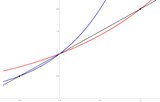e (mathematical constant)
[math]\displaystyle{ \boldsymbol e }[/math] is a number. It is the base of the natural logarithm and is about 2.71828.[1][2] It is an important mathematical constant. The number [math]\displaystyle{ e }[/math] is occasionally called Euler's number after the Swiss mathematician Leonhard Euler, or Napier's constant in honor of the Scottish mathematician John Napier who introduced logarithms. It is equally important in mathematics as [math]\displaystyle{ \pi }[/math] and [math]\displaystyle{ i }[/math]. [math]\displaystyle{ e }[/math] is an irrational number, and Euler himself gave the first 23 digits of [math]\displaystyle{ e }[/math].[3]
The number [math]\displaystyle{ e }[/math] has great importance in mathematics,[4] as do 0, 1, [math]\displaystyle{ \pi }[/math], and [math]\displaystyle{ i }[/math]. All five of these numbers are important and occur again and again in mathematics. The five constants appear in one formulation of Euler's identity. Like the constant [math]\displaystyle{ \pi }[/math], [math]\displaystyle{ e }[/math] is also irrational (it cannot be represented as a ratio of Integers)[5] and transcendental (it is not a root of any non-zero polynomial with rational coefficients).[2]
The number [math]\displaystyle{ e }[/math] is very important for exponential functions. For example, the exponential function applied to the number one, has a value of [math]\displaystyle{ e }[/math].
[math]\displaystyle{ e }[/math] was discovered in 1683 by the Swiss mathematician Jacob Bernoulli, while he was studying compound interest.[6] The numerical value of [math]\displaystyle{ e }[/math] truncated to 20 places is:[5]
- [math]\displaystyle{ e\approx2.71828182845904523536 }[/math]
Alternate definitions of e
There are many different ways to define [math]\displaystyle{ e }[/math]. Jacob Bernoulli, who discovered [math]\displaystyle{ e }[/math], was trying to solve the problem:
- [math]\displaystyle{ \lim_{n\to\infty}(1+\frac1n)^n. }[/math]
In other words, there is a number that the expression [math]\displaystyle{ (1+\frac1n)^n }[/math] approaches as [math]\displaystyle{ n }[/math] becomes larger. This number is [math]\displaystyle{ e }[/math].
Another definition is to find the solution of the following formula:
- [math]\displaystyle{ 2+\cfrac{2}{2+\cfrac{3}{3+\cfrac{4}{4+\cfrac{5}{5+\cfrac{6}{\ddots\,}}}}} }[/math]
E (mathematical Constant) Media
The five colored regions are of equal area, and define units of hyperbolic angle along the {{{1}}}
The global maximum of √x occurs at x = e.
Related pages
References
- ↑ "Compendium of Mathematical Symbols". Math Vault. 2020-03-01. Retrieved 2020-09-22.
- ↑ 2.0 2.1 Weisstein, Eric W. "e". mathworld.wolfram.com. Retrieved 2020-09-22.
- ↑ Euler, Leonhard (1748). Introductio in analysin infinitorum. M. M. Bousquet. p. 90.
- ↑ Howard Whitley Eves (1969). An Introduction to the History of Mathematics. Holt, Rinehart & Winston. ISBN 978-0-03-029558-4.
- ↑ 5.0 5.1 "e - Euler's number". www.mathsisfun.com. Retrieved 2020-09-22.
- ↑ J J O'Connor; E F Robertson. "The number e". St Andrews University.







